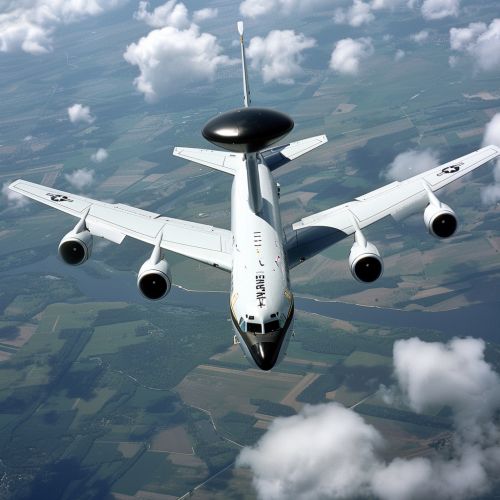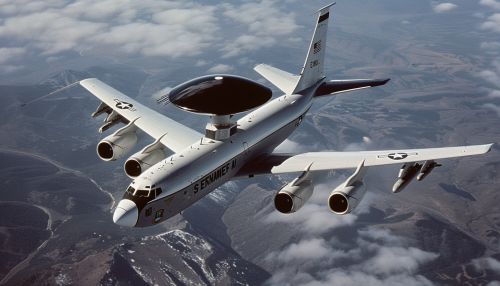E-3 Sentry
Overview
The Boeing E-3 Sentry is a United States military airborne warning and control system (AWACS) aircraft that provides all-weather surveillance, command, control, and communications. It is distinguished by the distinctive rotating radar dome above its fuselage. The aircraft is based on the Boeing 707 commercial frame.


Development
The E-3 Sentry's development began in 1963 when the United States Air Force (USAF) asked for a replacement for its piston-engined Lockheed EC-121 Warning Star, which had been in service since the early 1950s. After a competition, Boeing was selected to develop the aircraft. The E-3 Sentry first flew in 1975 and was delivered to the USAF in 1977.
Design
The E-3 Sentry's most noticeable feature is the 30-foot (9.1 m) diameter rotodome that houses the pulse-Doppler radar antennae. The radar and computer subsystems can gather and present broad and detailed battlefield information. Data is collected as events occur. This includes position and tracking information on enemy aircraft and ships, and location and status of friendly aircraft and naval vessels. The information can be sent to major command and control centers in rear areas or aboard ships.
Operational History
The E-3 Sentry has been involved in many key military engagements since its introduction, including the Gulf War, the NATO bombing of Yugoslavia, and the War in Afghanistan. Its capabilities have proven invaluable in coordinating and controlling friendly forces, and in detecting and tracking enemy forces.
Variants
Several variants of the E-3 Sentry have been produced, including the E-3B, E-3C, and E-3D. These variants primarily differ in their radar and computer systems, with each new variant incorporating technological advancements to enhance the aircraft's capabilities.
Operators
The primary operator of the E-3 Sentry is the United States Air Force. Other operators include the Royal Air Force of the United Kingdom, the French Air and Space Force, and the Royal Saudi Air Force.
Future
The E-3 Sentry is expected to remain in service with the USAF until at least 2035. However, the USAF has begun looking into potential replacements for the E-3, with the Boeing E-7 Wedgetail being considered as a possible candidate.
